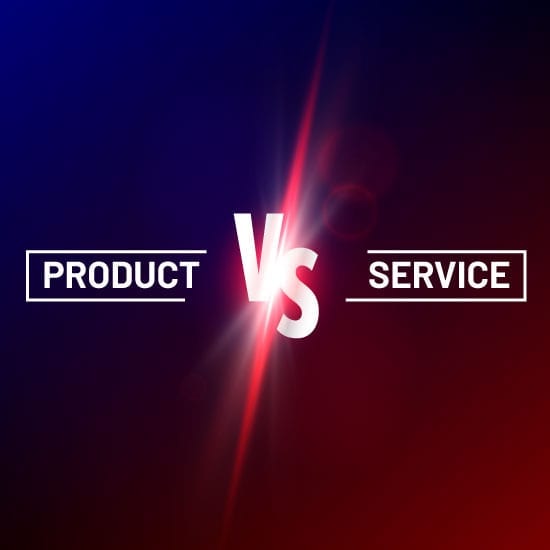How the IRS Treats Differently Product vs. Service Businesses?
General Differences Between Products and Services Businesses
The differences between businesses that primarily sell products versus those that sell services will help in understanding why the IRS has some very different tax treatment for them. There are three areas of business operations that have differing business financial and accounting factors for these two business types.
| PRODUCTS BUSINESS | SERVICES BUSINESS |
|---|---|
| Pricing For Sale | |
The products business maintains inventories of raw materials and finished products. The IRS has an inventory-specific rule for accounting and tax reporting. Though there are employees and training, a lot of the cost of operations is in labor, raw materials, manufacturing equipment, and shipping. Pricing of products must include the costs to maintain inventory, production, storage, and shipping/delivery. | The service business generally has no inventory for resale, though there may be some things like books sold in conjunction with some services. Or, a cleaning service may pass along costs for cleaning products, but as the IRS section will clarify, they aren’t normally required to follow inventory accounting practices. Service businesses usually must price based primarily on labor factors and perceived value of their services, which are not able to be counted or touched. |
| Common: Both business types price using formulas that mark up their costs and factor in their overhead and desired profit margins. | |
| Purchases | |
| Some purchases of the products business are assets to increase efficiency or production requiring different IRS tax treatment. | Most product and service purchases for use in a services business are deductible as business expenses in the year they’re purchased. |
| Common: Both types require the purchase of materials, supplies, products, and services. They both must claim them as business expenses, but with different tax treatment in some cases. | |
| Cash Flow | |
| The products business maintains inventory, sometimes quite large, both in the before and post-production phases. That presents cash flow opportunities and challenges that are not normally issues for the service business. | Cash flow is more straight-forward in a service business, as most sales are invoiced as delivered. There is usually less large equipment, other than vehicles, involved in delivering services. |
| Common: Both are concerned with cash flow and maintaining the ability to conduct business. Both may consider cash flow accounting adjustments if a business sale is being considered. |
How the IRS Treats the Products vs. Service Business
The common IRS rules for allowable deductions for both business types are generally:
- Expendable supplies
- Labor and labor taxes not involved in the direct production of products for sale
- Operating expenses related to office and non-production overhead
- Direct operating and maintenance costs for vehicles in the business
- Professional fees for business, legal, and accounting advice
There are a great many other less common deductible expenses that may work for both, but there are some distinct differences when it comes to IRS treatment of the products business.
Cost of Goods Sold for the Products Business
If you’re in the business of producing or purchasing goods or products for resale, the IRS says that you must value your inventory at the beginning and the end of each year to determine your cost of goods sold. The cost of goods sold may also include some business expenses.
To calculate gross profit for the year for taxes, the cost of goods sold is subtracted from the gross receipts of the business. You can’t deduct expenses included in the cost of goods sold in normal business expense deductions. From the IRS website, the following expenses are normally included in the cost of goods sold:
- Costs of products and raw materials, including freight.
- Storage and warehousing.
- Direct labor for those who produce the products (including pension and annuity plan contributions).
- Factory/production overhead.
The IRS uniform capitalization rules require that you capitalize the direct costs and part of the indirect costs for certain production or resale activities. Indirect costs can include:
- Interest
- Rent
- Processing
- Purchasing
- Storage
- Taxes
- Repackaging
- Handling
- Administrative costs
As these indirect costs move from deductibility to capitalization, there can be a corresponding increase in cash flow and profits in the year. The products business is always considering major purchases and production-related expenses in relation to expensing and capitalization for taxes.
The Small Business Taxpayer Exception
The IRS defines the small business taxpayer this way:
“Effective for tax years beginning after 12/31/2017, a small business taxpayer is a taxpayer that (a) has average annual gross receipts of $25 million or less for the 3 prior tax years and (b) is not a tax shelter (as defined in section 448(d)(3)). See section 471(c) and section 263A(i).”
As a small business taxpayer, you can change or adopt your method of accounting for inventories:
- Account for inventories in the same way as non-incidental materials and supplies.
- Conform to IRS rules related to conformance of inventory treatment in applicable financial statements. Complicated, and you’ll have to read about this in sections 451 and 471 of the IRS code.
Consult a tax professional for sorting out the treatment of inventories and cost of goods sold for tax purposes.

